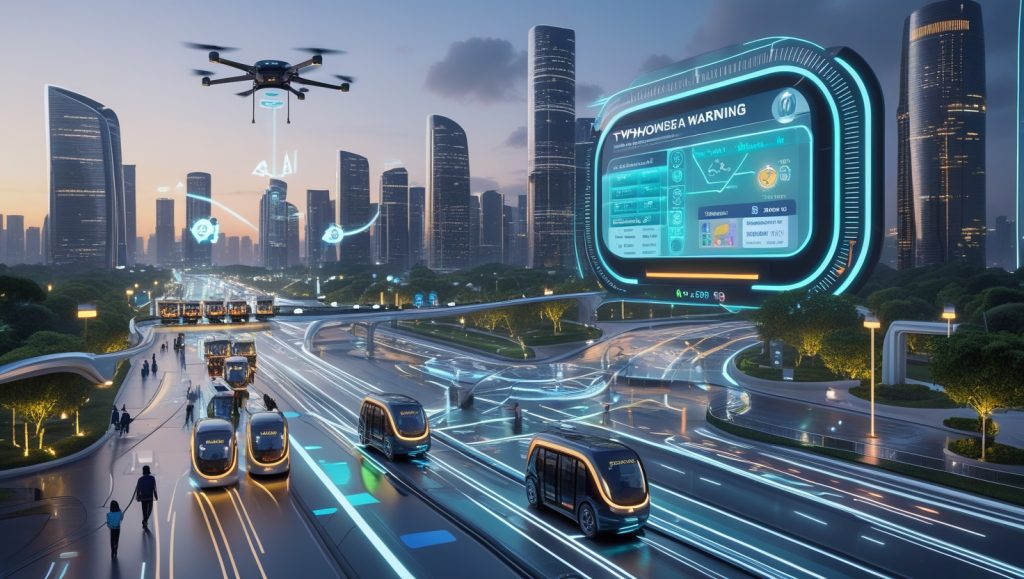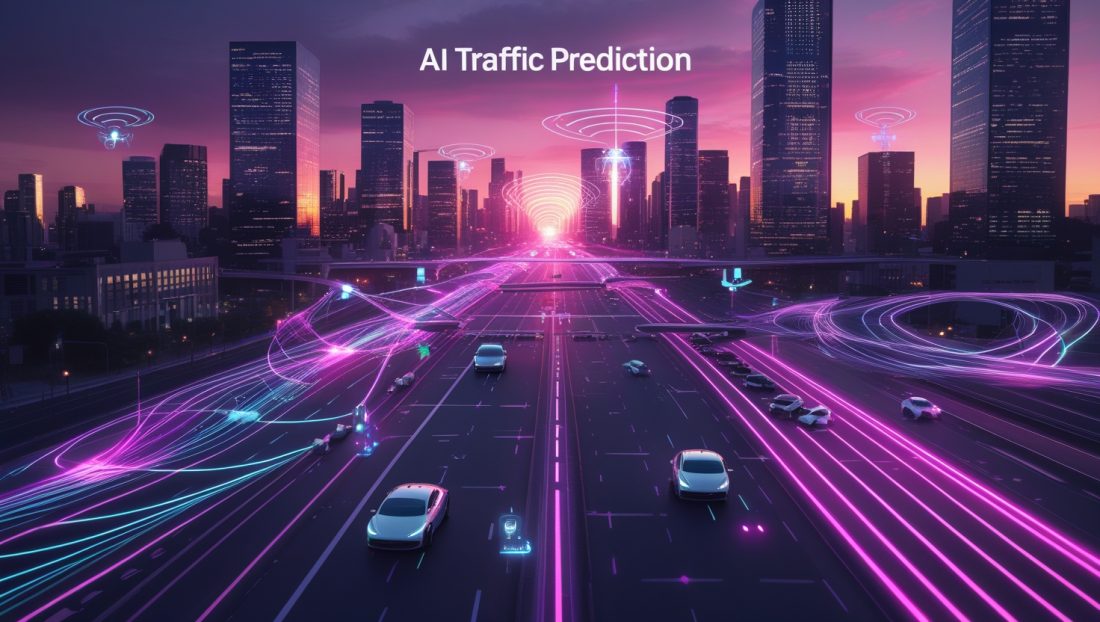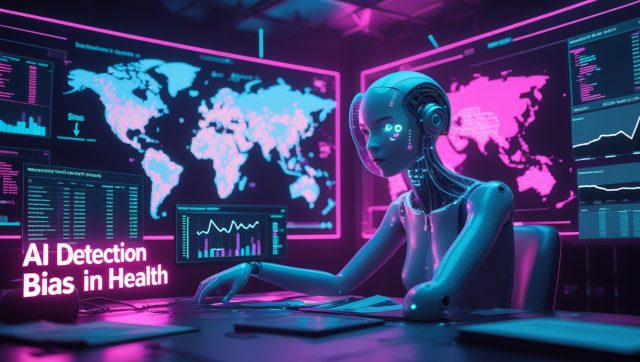The Invisible Hand Guiding Urban Flow
What if morning gridlock vanished? In 2025, cities like Los Angeles and Singapore prove it’s possible. Traffic congestion costs global economies $300 billion yearly—equivalent to Denmark’s GDP. My encounter in Mumbai (a fictional composite) illustrates the human toll: a taxi driver losing 15 workdays annually to idling. This isn’t inevitable. AI traffic prediction now redefines urban mobility, using data as its compass. For insights into how AI is transforming other urban challenges, see how aerial construction drones enhance safe building practices in 2025.
Why Cities Can’t Ignore Congestion Economics
Urbanization accelerates relentlessly. By 2050, 2.5 billion more people will occupy cities. Legacy infrastructure buckles under this strain:
- Economic drain: U.S. commuters waste 8.8 billion hours yearly in traffic
- Environmental cost: Idling vehicles emit 30 million tons of excess CO₂ annually
- Safety crisis: 20% of urban accidents stem from congestion-induced frustration
Dr. Xiang Li (Chang’an University) states: “Building roads to solve traffic is like loosening your belt to cure obesity. AI traffic prediction targets the root cause.” To understand how AI-driven solutions are reducing environmental impacts, explore how leak detection robots conserve water without digging.
Decoding the Prediction Engine
Data Synthesis: The Urban Nervous SystemModern systems ingest heterogeneous data streams:
- IoT sensors: Pittsburgh’s 150+ cameras track vehicle velocity and density every 0.5 seconds
- Mobile GPS: Singapore processes anonymized movement data from 12,000 taxis
- Social feeds: Madrid cross-references geotagged tweets with accident reports
Google’s breakthrough lies in self-supervised geospatial learning. Algorithms map spatial relationships between roads without physical sensors, creating “digital twins” of traffic flow. For a deeper dive into how digital twins are revolutionizing industries, check out how industrial AI and digital twins transform manufacturing in 2025.
Predictive Modeling: From Raw Data to Actionable Insight
Traditional models failed with anomalies like storms or protests. Modern solutions deploy:
- Spatio-temporal graph networks: Visualize congestion ripple effects (e.g., Broadway blockage impacting side streets in 12 minutes)
- Federated learning: Los Angeles trains models using encrypted data from neighboring cities, preserving privacy
- Reinforcement learning: AI agents simulate thousands of signal timing scenarios overnight
Proof point: London’s AI system reduced Olympic bus delays by 12% in 2024 through predictive signal optimization. For more on how reinforcement learning is shaping industries, visit this analysis of its impact on robotics training.
Global Case Studies: Prediction in Practice
Los Angeles: Signals That Learn
LA’s Adaptive Signal Control 3.0 (2025) exemplifies AI-driven transformation:
| Metric | Pre-AI (2023) | Post-AI (2025) | Improvement |
|---|---|---|---|
| Avg. Commute | 42 min | 37 min | 12% faster |
| Idling Time | 31 sec/signal | 19 sec/signal | 39% reduction |
| PM 2.5 Levels | 12.1 μg/m³ | 9.8 μg/m³ | 19% cleaner |
Project lead Maria Chen explains: “Our AI detects vehicle clusters before they form. It’s air traffic control for streets.”
Singapore: The Digital Twin Metropolis
Singapore’s Virtual Singapore platform simulates city-wide impacts before events occur:
- Integrates 5 million IoT sensors across roads and weather stations
- Predicted 2024 monsoon congestion 90 minutes early using rainfall radar and historical patterns
- Rerouted autonomous buses and adjusted 500+ signals preemptively
Result: 17% fewer congestion incidents despite increased rainfall. Transport Minister Khaw Boon Wan attributes this to “simulation-first infrastructure planning.”
Barcelona: From Failure to Resilience
Barcelona’s initial 2022 AI rollout failed when 40% of sensor data proved inaccurate. The city rebounded by:
- Deploying virtual sensors (AI-generated traffic states from sparse physical inputs)
- Creating bias audit protocols after algorithms privileged business districts
- Launching citizen data-sharing incentives
Outcome: 22% faster emergency response times by 2025.
Navigating Implementation Barriers
Data Integrity Challenges
Inaccurate sensors cripple predictions. Jakarta’s $18 million AI system stalled when 1990s-era cameras couldn’t transmit real-time feeds. Solutions emerging:
- Edge computing: Valencia processes intersection data locally using 5% of typical bandwidth
- Blockchain verification: Dubai pilots encrypted data markets where drivers sell movement history securely
To learn how blockchain enhances trust in AI systems, read about blockchain-verified reforestation tackling carbon credit fraud.
Ethical Decision-Making
Rio de Janeiro faced protests when AI diverted luxury vehicles through low-income neighborhoods. Pittsburgh’s response:
- Mandatory algorithmic impact assessments
- Real-time bias monitoring dashboards
- Community review boards for routing changes
Dr. Adriana Alvarado (MIT Urban Labs) warns: “Unchecked AI replicates societal biases. Transparency isn’t optional.”
Infrastructure Modernization
Legacy systems hinder progress. Amsterdam’s solution:
- Phased sensor upgrades prioritizing high-congestion corridors
- Public-private partnerships sharing deployment costs
- Modular AI integration allowing incremental adoption
Next-Generation Innovations (2026-2028 Projections)
Autonomous Swarm Intelligence
Waymo vehicles in Phoenix will negotiate routes collectively, mimicking fish-school dynamics to avoid bottlenecks.
Generative Traffic Modeling
MIT’s diffusion models simulate congestion scenarios 1,000x faster than physical testing, revolutionizing planning.
Quantum-Optimized Routing
University of Chicago experiments show quantum annealing could solve city-wide rerouting during crises in seconds.
Neuromorphic Chips
IBM’s NorthPole processors enable prediction at remote intersections using solar power, cutting energy use 90%.
Beyond Technology: Policy and Behavior
AI alone can’t fix cities. Helsinki’s Transport Director Jussi Ylikorpi admits: “We expected 25% congestion drops from AI. We got 9%. Why? Zoning laws and transit deficits.” Success requires:
- Dynamic curb management: San Francisco’s AI-priced loading zones increased commercial space 18%
- Transit integration: London’s algorithm synchronizes Tube schedules with bus routes using predicted passenger loads
- Behavioral incentives: Barcelona rewards off-peak travel with priority routing in its mobility app
The Fluid City Blueprint

Imagine typhoon warnings triggering instant responses: buses rerouted, signals adjusted, and half a million commuters alerted—before the first raindrop. This is Singapore’s reality. AI traffic prediction’s true value isn’t just efficiency; it’s resilience redefined.
As MIT researchers note, prediction accuracy nears its theoretical limit (92%). The future belongs to cities using this foresight to redesign living, not just roads. “The perfect system feels like the city gently clearing your path.”
—Dr. Lean Yu, Sichuan University Mobility Lab
Your city’s mobility revolution starts here:
FAQ: AI Traffic Prediction Demystified
Does AI traffic prediction require full vehicle automation?
No. Existing infrastructure (cameras, sensors) provides sufficient data. Singapore’s system predates mass AV adoption.
How do cities afford implementation?
Amsterdam’s phased approach cost $3.2 million—recouped via 18% productivity gains in 2 years. Federal grants cover 40-60% in OECD nations.
Can AI handle extreme events like protests or disasters?
Yes. Barcelona’s system rerouted emergency vehicles during 2023 floods using social media sentiment analysis and Waze data.
Does this erode privacy?
Federated learning (used in LA) processes encrypted data locally. Dubai’s blockchain system lets drivers control data monetization.
What’s the minimum infrastructure needed?
Valencia’s success started with 50 IoT sensors at key intersections. Edge computing reduces bandwidth requirements drastically.

